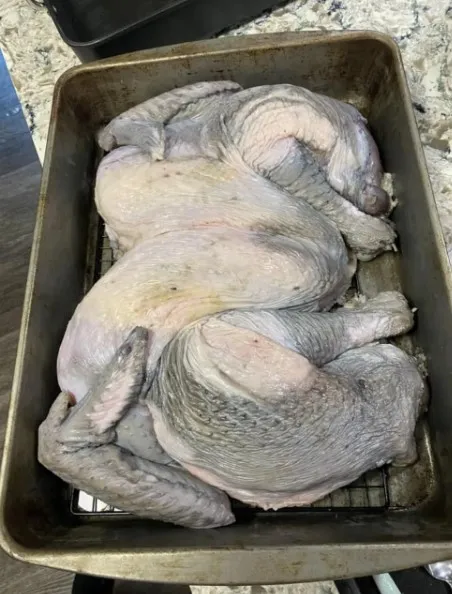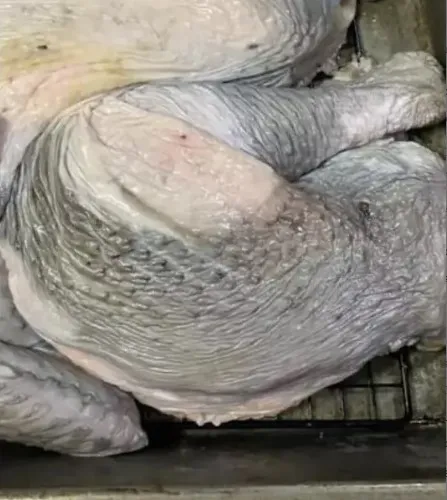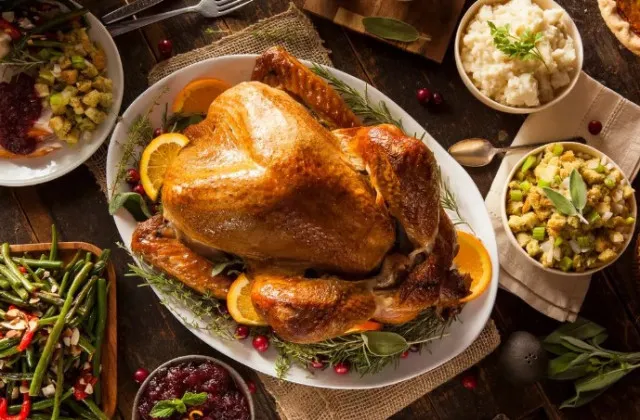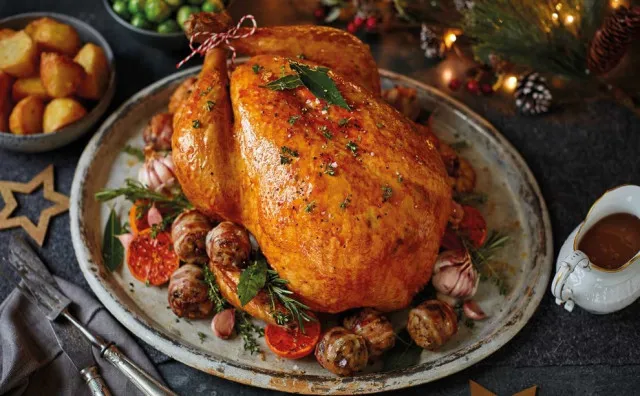The festive season is a time for gathering with loved ones, indulging in delicious meals, and creating cherished memories. However, one man’s Christmas dinner took an unexpected twist when his turkey turned an alarming shade of grey. This peculiar incident has sparked widespread discussion and serves as a cautionary tale for anyone brining a turkey this holiday season. Let’s dive into what went wrong and how to avoid such culinary disasters.
What Happened to the Turkey?

The man, eager to prepare a flavorful turkey, shared his puzzling experience online. After brining the bird for 24 hours in a metal pan, he discovered it had turned grey. Naturally, this bizarre outcome left him—and everyone who saw the post—shocked and confused.
Experts were quick to explain the phenomenon: a chemical reaction between the salt in the brine and the metal pan caused the discoloration. The turkey absorbed particles from the reactive pan, resulting in its unappetizing appearance. This incident is a reminder of how even small oversights in the kitchen can lead to big problems.
The Science Behind the Grey Turkey
At the heart of the issue is the interaction between reactive metals and salt. When salt from the brine comes into contact with certain metals, such as aluminum or uncoated steel, a chemical reaction occurs. This process can leach metallic particles into the food, altering its color and potentially its safety.
The lesson? Always choose your tools carefully in the kitchen. Not all containers are created equal, especially when dealing with acidic or salty ingredients like brine.
Choosing the Right Brining Container
Selecting the proper container is essential for a successful brining process. Here are some tips to ensure your turkey remains both visually appealing and safe to eat:
- Use Non-Reactive Materials: Opt for containers made of glass, ceramic, or food-grade plastic. These materials don’t interact with salt or acidic ingredients and will keep your turkey looking its best.
- Avoid Certain Metals: Aluminum and uncoated steel pans are reactive and can cause unwanted chemical reactions. Stainless steel is a safer choice if metal is your only option.
- Consider Size and Shape: Ensure the container is large enough to submerge the entire turkey in the brine, allowing for even flavoring.
Health Risks of a Grey Turkey
While a grey turkey might look unappetizing, the bigger concern lies in its safety. Experts warn against consuming such discolored meat, as the chemical reaction could introduce harmful substances. The discoloration isn’t just cosmetic—it’s a red flag that the turkey may have absorbed materials from the pan.
If you ever encounter a similar situation, the best course of action is to discard the turkey. While waste is unfortunate, the potential health risks aren’t worth taking the chance.
How to Brine a Turkey Safely

Brining can enhance a turkey’s flavor and tenderness, but doing it correctly is key. Follow these steps to avoid a holiday disaster:
- Choose the Right Container: Use a non-reactive container, such as a glass or ceramic bowl, or a food-safe plastic bag specifically designed for brining.
- Prepare the Brine: Combine salt, sugar, and your choice of herbs and spices with water to create a flavorful solution.
- Submerge the Turkey: Make sure the turkey is fully submerged in the brine and store it in a cool environment, such as a refrigerator.
- Time It Right: Brine the turkey for 12 to 24 hours. Over-brining can lead to overly salty meat, so avoid exceeding this timeframe.
- Rinse and Dry: Once the brining process is complete, rinse the turkey thoroughly under cold water to remove excess salt. Pat it dry before cooking.
Cooking the Perfect Turkey

Once your turkey is brined and ready, it’s time to cook it to perfection. Proper preparation and cooking techniques are essential for a safe and delicious meal.
- Thaw Thoroughly: Ensure the turkey is completely thawed before cooking. A partially frozen bird can cook unevenly, leaving harmful bacteria alive.
- Use a Meat Thermometer: Check that the internal temperature of the turkey reaches 165°F (75°C) in the thickest parts to ensure it’s safe to eat.
- Follow Cooking Times: Cook your turkey based on its weight, and try not to open the oven too frequently, as this can disrupt the cooking process.
Safety Tips for Holiday Cooking
Holiday cooking can be stressful, especially when preparing meals for a large gathering. Here are some additional tips to keep your kitchen safe and efficient:
- Be Mindful of Deep-Frying: If you’re deep-frying your turkey, do so outdoors on a stable surface. Make sure the turkey is completely dry to prevent oil splatters, and keep a fire extinguisher nearby.
- Stay Focused: Avoid distractions while cooking. Multitasking may lead to burned dishes or safety hazards.
- Keep the Kitchen Safe: Make sure kids and pets stay out of the kitchen to avoid accidents.
- Check for Fire Hazards: Be cautious with candles, Christmas decorations, and greasy ovens to reduce the risk of fires.
Lessons from the Grey Turkey

This strange tale of a grey turkey is more than just an internet oddity. It’s a stark reminder of the importance of preparation and attention to detail in the kitchen. From choosing the right brining container to following safety protocols, these small steps can make a big difference in your holiday cooking experience.
Conclusion
The story of the grey turkey highlights the importance of proper preparation and kitchen safety. By understanding the science behind the discoloration, choosing the right tools, and following safe cooking practices, you can avoid similar mishaps and serve a delicious, picture-perfect turkey this holiday season. So double-check your brining setup, keep these tips in mind, and enjoy a festive feast with confidence!


